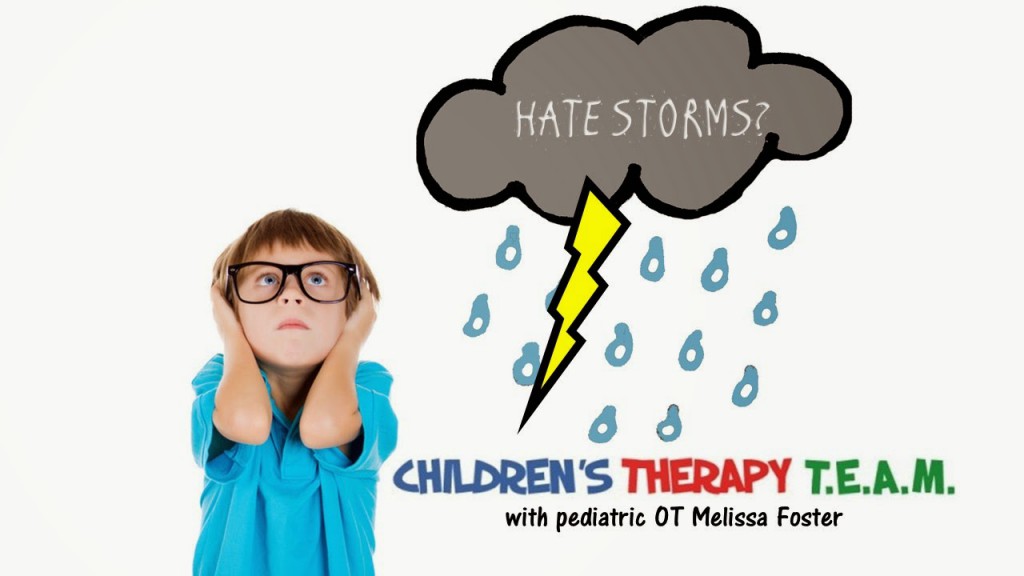 |
| credit: Envato Images |
Dear Melissa,
I have a 7-year-old son with a diagnosis of Autism. He is very sensitive to sounds and HATES thunderstorms. Do you have any tips for helping us cope with the thunder or advice on what to do in case we need to seek shelter during a tornado warning?
A child’s fear of thunderstorms (astraphobia) can be very difficult for families to navigate. Sound sensitivity or auditory defensiveness is an extremely common occurrence for children with Autism and Sensory Processing Disorders.
I can always tell which kiddos at a birthday party are auditory defensive because they are the ones that put their hands over their ears during the singing of “Happy Birthday”.
Thunderstorms are much louder and much less predictable than singing happy birthday. During storms, I generally distract children from their fears while working with them at our Children’s Therapy TEAM clinic. However, this technique is likely more difficult at home because home is often quieter than our busy clinic. So, I turned to those who have taught me so much over the years…my clients!
Ideas about how to deal with storms:
Shared by a mom with a boy with Autism (7), a dad with a daughter with Autism (13) and a girl (10) who also has Autism.
Social stories:
These little nuggets are truly magical. If you have never heard of these before, I highly recommend them for any anxious situation. You simply make up a story with the child as the main character (write it down and illustrate it). The story should describe the scary situation as well as a proper solution.
Early warning:
Social stories are a great place to start, but hopefully you will be able to move on to the point that the child just needs some warning that it may be a stormy evening. Don’t we all like to have a heads up about the weather? Simply knowing that there may be a change in the routine that day may be enough for many children to remain calm during the storm.
iPad:
I have written many blogs explaining why I think screen time should be limited. However, this is a time to break out the iPad and use it as a portable distraction, especially if you have to seek safety in your tornado shelter area.
Blankets/pillows/stuffed animals:
Often a child can bury himself in pillows and blankets to help muffle the sounds. They are also very useful for providing calming deep pressure. Who knows, your little one may even drift off to sleep!
Headphones:
One Dad reported that his daughter started out with shooting-range ear protection, then was able to move to music headphones, before stopping them all together. Other items that can help block out the sound of thunder include ear plugs, ear muffs, and pulling up a hoodie or blanket over the head.
Desensitization:
Your OT can help you with this one. Desensitization involves gradually exposing someone to something that they usually find difficult. Over time, it becomes more tolerable. You may start with more soothing nature sounds such as the ocean or a stream, and you can gradually increase the volume over several exposures. Then, move on to the sounds of a thunderstorm at a very low volume before gradually increasing the volume of that sound over many exposures.
Fidgets:
My client in the clinic said that having fidgets (e.g., Koosh balls, slinkies, water timers, stress balls, and squishy rubber animals) during thunderstorms or in tornado shelters helps make her feel much calmer.
Role Play:
Though tornadoes in Northwest Arkansas are relatively uncommon, they do happen. Identify your “safe place” tornado shelter. Decide what you need to take with you ahead of time, and practice using your sensory techniques while sitting in your shelter. Gradually increase the time spent in your shelter area so that your child can tolerate being in the shelter with you for at least 5-10 minutes at a time (though you will likely be in there much longer for a real tornado warning).
What techniques does your family use to help survive thunderstorm season?
I would love to get even more ideas from you!
email: share@childrenstherapyteam.com
Additional helpful information:
Explore Helpful Strategies to Ease Child’s Fear of Thunderstorms Chicago Tribune (published May 2013)
Storm Prediction Center: Tornado Safety (downloaded April, 2015)
Weather Worries Children’s Hospitals & Clinics of Minnesota (downloaded 2015)
Tornado Preparedness: Tips for Families Healthychildren.org (downloaded April, 2015)
